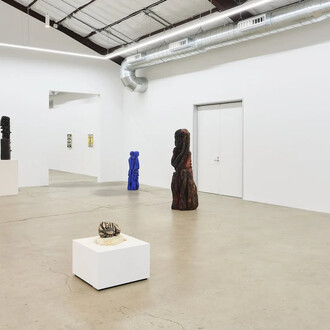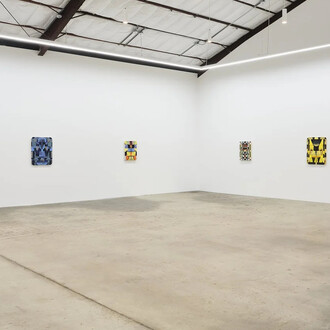Since 2006 Gegam Kacherian’s paintings might best be described as a journey into a hallucinogenic or dreamlike whirlwind. Dynamic compositions with allusions to Western art history from the Baroque to Surrealism incorporate a vast array of finely detailed, photo inspired representational images, folk art decorative motifs, and swirling, psychedelia inspired gestural “mini paintings”, often set within vibrant landscapes. In Kacherian’s painted world, the borders between fantasy and reality, magic and observable fact, the cosmic and personal, the past and present, the superficial and the deep, are breached, creating metaphors for the complicated experience of contemporary life.
In this latest series, Kacherian, restless to further explore his formal possibilities and never satisfied with previous victories, has expanded his conversation with the photograph; instead of simply source material as in the earlier works on canvas, the photograph has been elevated to an essential component at times indistinguishable from the painted image. Photography and painting have historically maintained an antagonistic relationship, with the emergence of photo realist painting in the 1960’s attempting to harmonize the photographer’s ease in creating compelling images with a painter’s inimitable touch. The mediums, however, were never confused for each other. Fast forward to the present where no certainties whatsoever exist; defined art categories, gender, nationalities, predictable seasons, political protocols are constantly shifting and morphing. Much critical verbiage is expended trying to comprehend these monumental changes.
Kacherian in, seeing “how far from painting one can go and still be a painting” takes viewers into the eye of that storm. Moving from pure painting, he now employs a process of collaging from his collection of photographs, re- photographing and Photoshopping the assembled images, then printing the photo images on Mylar. From there, exquisite painted “doodles” are applied, gyrating and dancing across the surface, or in some cases, augmenting the figurative elements or enlivening broad expanses of rich color. Exotic flora and fauna, bisected architecture, human nudes and atmospheric effects play hide and seek in these wildly polychromed spaces. Painted areas can be difficult to differentiate from reproductions. Abstraction becomes figuration and figuration dissolves into gorgeous painted puddles. Refracting stained glass windows, kaleidoscopes, Cubist painting, Op Art, Kandinsky’s early abstractions, all come to mind. The effects are mesmerizing, especially when in catching a fleeting glimpse of oneself in the reflective Mylar, one realizes he/she is part of this fluctuating vision.
Kacherian has described these newer hybridizations of painting and photography as “trying to translate ideas of differences”—for example, day v. night, here v. there. Interpreting his intentions as a dualistic contest, however, is to not grasp the larger implications of these artworks. Questions of difference and contrast are certainly engaged throughout, particularly when trying to discern pictorial genres, fixed identities, locations, and perspectives. In Kacherian’s these elements veer and shift imparting a sense of instability and precarity. Refractions dramatically visualizes a world transforming right before us.














